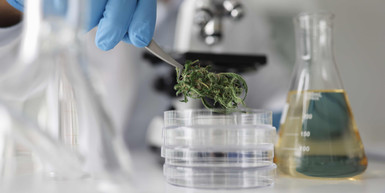Posted by TL Knowledge Team on 16th Jan 2024
Understanding the Role of Terpenes in Enhancing the Effects of Cannabinoids
In the expansive universe of cannabis, cannabinoids -like THC and CBD- have long held the spotlight, championed for their diverse therapeutic benefits. However, a deeper dive into the cannabis plant uncovers other crucial elements that play an equally significant role in shaping your cannabis experience. Among these are terpenes, the aromatic molecules responsible for the unique fragrance of each cannabis strain. Beyond their aromatic qualities, terpenes are gaining recognition for their potential to enhance the effects of THC and CBD.
What are terpenes?
These are organic compounds produced by various plants, including cannabis. They contribute to the aroma, flavor, and color of the plants, providing distinctive sensory experiences. More than this, terpenes interact synergistically with other compounds in the plant, such as cannabinoids like THC and CBD, enhancing their effects in what is popularly known as the "entourage effect."
Terpenes like limonene, linalool, pinene, myrcene, and caryophyllene present in cannabis lend a unique character to each strain. Limonene, as the name suggests, imparts a citrusy aroma and is associated with mood enhancement and stress relief. Linalool, with its floral scent, is believed to promote relaxation and has potential anti-inflammatory and analgesic properties.
Pinene, with its characteristic pine-like aroma, is associated with memory enhancement, making it an important terpene for counteracting potential memory impairment associated with excessive use of THC. Myrcene, the most abundant terpene in most cannabis strains, exudes an earthy aroma and is believed to synergise with THC to potentiate its psychoactive effects.
Role of Terpenes
Now, let's dive into the role of these terpenes in influencing the effects of THC and CBD. Starting with THC, caryophyllene, a terpene that has a peppery aroma, interacts directly with the CB2 receptors in our endocannabinoid system, similar to CBD. This interaction is believed to offer therapeutic benefits such as anti-inflammatory and pain-relieving effects. By enhancing the availability of these receptors for THC, caryophyllene may amplify THC's therapeutic potential.
Furthermore, research suggests that myrcene might enhance the psychoactivity of THC by allowing it to cross the blood-brain barrier more efficiently. This 'couch-lock' effect of myrcene could explain why certain cannabis strains induce stronger psychoactive effects than others.
For CBD, linalool can be a significant game-changer. This terpene is also found in lavender and is associated with calming effects. When combined with CBD, it might enhance the cannabinoid's potential anti-anxiety and stress-relieving properties. This combination could be beneficial for individuals suffering from anxiety disorders or those looking to reduce stress.
Shaping the Experience
As we unearth more about the synergistic play of terpenes and cannabinoids, it's evident that the cannabis experience is much more than just THC and CBD. Terpenes, with their aromatic and potential therapeutic properties, play a crucial role in shaping this experience.
Understanding the dynamics of terpenes can significantly impact your choices when browsing for cannabis products. Whether you're on the hunt for relaxation, stress relief, or an energy boost, there's a terpene profile to suit your needs. So next time you're researching CBD oil ingredients, looking for the perfect terpenes to distillate ratio, or comparing terpene suppliers, don't forget to consider the power and potential of terpenes.
Interested in exploring the world of terpenes further? Check out our range of pure cannabis-extract terpenes and botanical blends. They can help you personalise your cannabis experience while allowing you to tap into the potential therapeutic benefits of these amazing compounds.
Terpenes: they're the secret sauce that brings out the best in your cannabis experience, enhancing both flavour and functionality.
References
- Russo, E. B. (2011). Taming THC: potential cannabis synergy and phytocannabinoid-terpenoid entourage effects. British Journal of Pharmacology, 163(7), 1344-1364. DOI: 10.1111/j.1476-5381.2011.01238.x
- Gallily, R., Even-Chena, T., Katzavian, G., Lehmann, D., Dagan, A., & Mechoulam, R. (2003). Gamma-irradiation enhances apoptosis induced by cannabidiol, a non-psychotropic cannabinoid, in cultured HL-60 myeloblastic leukemia cells. Leukemia & Lymphoma, 49(10), 2000-2006. DOI: 10.1080/10428190802239188
- Fisar, Z. (2009). Phytocannabinoids and endocannabinoids. Current Drug Abuse Reviews, 2(1), 51-75. DOI: 10.2174/1874473710902010051
- Russo, E.B., Marcu, J. (2017). Cannabis Pharmacology: The Usual Suspects and a Few Promising Leads. Advances in Pharmacology, 80, 67-134. DOI: 10.1016/bs.apha.2017.03.004

